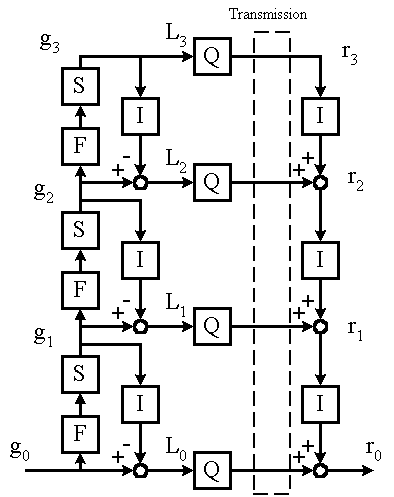|
|||||||||||||||||||||||||
|
|
|||||||||||||||||||||||||
 |
|||||||||||||||||||||||||
|
(click on the variables to see the images) |
|||||||||||||||||||||||||
|
|||||||||||||||||||||||||
| Here is how a pyramid coder works. The original image g0 is filtered and subsampled resulting in a higher level Gaussian pyramid g1. Difference image L0 is formed by subtracting the interpolation of g1 from the original image. This process is repeated to give higher levels of the pyramid. Then the difference images are quantized and transmitted. The image is reconstructed by interpolating and adding images in each level.
In their 1983 paper [1], Burt and Adelson used a linear filter and interpolator. The 2D filter are of size 5x5 having the weight
where
We use a = 0.4. And we use uniform quantizers with step-sizes 32, 16, 8, 4 from bottom to top respectively. The interpolation is somewhat the inverse of the filtering. Please click on the figure above to see the results. Since a low-pass filter and interpolator are used, the reconstructed image is blurred. We attempt to reduce this effect by a nonlinear interpolator in the next section. The PSNR is 32.77 and the bit-rate is 0.8278 bit/pixel. Note that the pyramid coder has to transmit more pixels than the original image. We have already taken this into account when calculating the bit-rate. In this project, the pyramid structure and the quantizers are held fixed. We only change the filter and the interpolator. |
|||||||||||||||||||||||||
|
|||||||||||||||||||||||||
